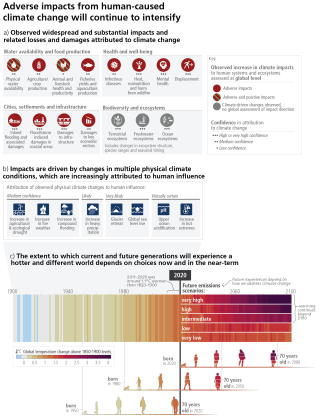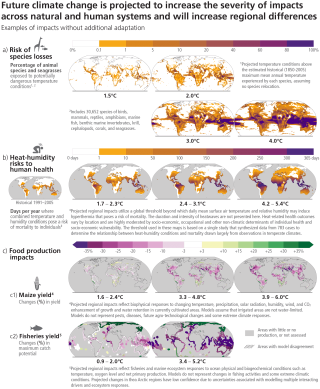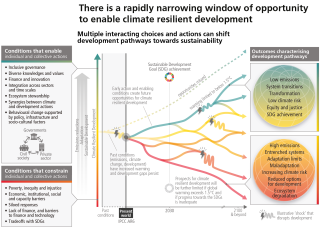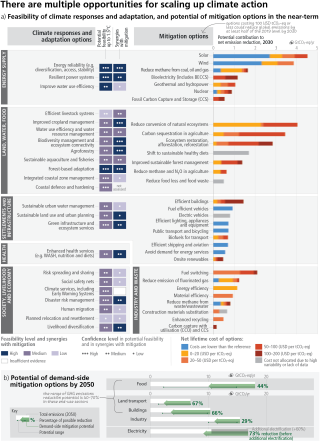IPCC Synthesis Report - immediate and radical climate mitigation measures required

The latest report from the IPCC warns that the pace and scale of climate action are insufficient to tackle climate change. If current trends continue, adverse impacts from human-caused change will intensify leading to water scarcity and knock-on impacts on food production, negative impacts on people’s health and wellbeing, the infrastructure of human settlements and ecosystem structure. Weather and temperature extremes become more widespread and pronounced with every increment of warming. However, the authors maintain that there is hope if we act now. Mainstreaming effective and equitable climate action now will reduce losses and damages for nature and people. Multiple and feasible options are available to reduce GHG emissions and adapt to human-caused climate change.
The Synthesis Report (SYR) of the IPCC Sixth Assessment Report (AR6) summarises the state of knowledge of climate change, its widespread impacts and risks, and climate change mitigation and adaptation.
Current status and trends:
- Human activities, principally through emissions of greenhouse gases, have unequivocally caused global warming, with global surface temperature reaching 1.1°C above 1850–1900 in 2011–2020.
- Global greenhouse gas emissions have continued to increase, with unequal historical and ongoing contributions arising from unsustainable energy use, land use and land-use change, lifestyles and patterns of consumption and production across regions, between and within countries, and among individuals.
- Widespread and rapid changes in the atmosphere, ocean, cryosphere and biosphere have occurred. Human-caused climate change is already affecting many weather and climate extremes in every region across the globe.
- This has led to widespread adverse impacts and related losses and damages to nature and people. Vulnerable communities who have historically contributed the least to current climate change are disproportionately affected and are often the most vulnerable to its impacts. Millions are exposed to acute food insecurity and reduced water security. The biggest impacts are in parts of Africa, Asia, Central and South America, LDCs, Small Islands that Arctic.
- People in highly vulnerable areas are up to 15 times more likely to die in floods, droughts, storms compared to those in more resilient areas.
- Global GHG emissions in 2030 implied by nationally determined contributions (NDCs) announced by October 2021 make it likely that warming will exceed 1.5°C during the 21st century and make it harder to limit warming below 2°C

Source: IPCC
Future Climate Change, Risks, and Long-Term Responses:
- Some future changes are unavoidable and/or irreversible but can be limited by deep, rapid and sustained global greenhouse gas emissions reduction.
- Adaptation options that are feasible and effective today will become constrained and less effectivewith increasing global warming. With increasing global warming, losses and damages will increase and additional human and natural systems will reach adaptation limits.
- The challenge we face is to cut emissions quickly and sharply to create a safer, sustainable world. This means scaling up practices and infrastructure to enhance resilience. The world needs to cut global GHG emissions by nearly half by 2030.
- The level of greenhouse gas emission reductions this decade largely determine whether warming can be limited to 1.5°C or 2°C. Projected CO2 emissions from existing fossil fuel infrastructure without additional measures and adaptation policies would exceed the remaining carbon budget for 1.5°C.

Source: IPCC
Why immediate action is required
- Deep, rapid and sustained mitigation and accelerated implementation of adaptation actions in this decade would reduce projected losses and damages for humans and ecosystems, and deliver many co-benefits, especially for air quality and health.
- Delayed mitigation and adaptation action would lock-in high-emissions infrastructure, raise risks of stranded assets and cost-escalation, reduce feasibility, and increase losses and damages.
- Near-term actions involve high up-front investments and potentially disruptive changes that can be lessened by a range of enabling policies.
- Rapid and far-reaching transitions across all sectors and systems are necessary to achieve deep and sustained emissions reductions and secure a liveable and sustainable future for all.
- These system transitions involve a significant upscaling of a wide portfolio of mitigation and adaptation options.
- Feasible, effective, and low-cost options for mitigation and adaptation are already available, with differences across systems and regions.
- The world needs 3 to 6 times the current climate investment. There is enough global financing to rapidly reduce emissions. Developing countries required external funding to meet adaptation needs.

Source: IPCC
Policies and adaptation actions are available action - fairness in implementation is crucial
- Accelerated and equitable action in mitigating and adapting to climate change impacts is critical to sustainable development.
- Mitigation and adaptation actions have more synergies than trade-offs with Sustainable Development Goals.
- Prioritising equity, climate justice, social justice, inclusion and just transition processes can enable adaptation and ambitious mitigation actions and climate resilient development.
- Integrating climate adaptation into social protection programs improves resilience. Many options are available for reducing emission-intensive consumption, including through behavioural and lifestyle changes, with co-benefits for societal well-being.
Finance, technology and international cooperation are critical enablers for accelerated climate action. If climate goals are to be achieved, both adaptation and mitigation financing needs to increase significantly.
There is sufficient global capital to close the global investment gaps but there are barriers to redirect capital to climate action.
Climate resilient development
The report identifies climate-resilient development as a pathway forwards. Climate resilient development means integrating measures to adapt to climate change with actions to reduce emissions in ways that provide wider benefits by:
- Improving peoples health and livelihoods
- Reducing poverty and hunger
- Clean energy, water and air.
Five key enablers for effective climate action are identified in the report:
- political commitment
- inclusive governance
- international cooperation
- effective ecosystem stewardship
- sharing of diverse knowledge

Source: IPCC
Ireland must escalate the implementation climate adaptation policies across all sectors and also allocate the upfront investment required to ensure alternatives are in place to support people, communities and business who will be most impacted in the near term with the significant changes required.